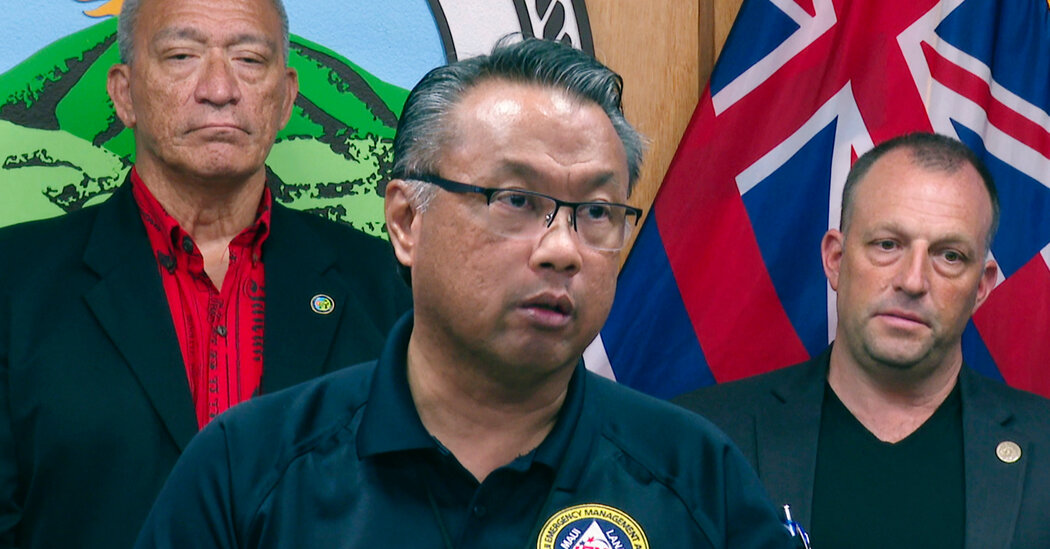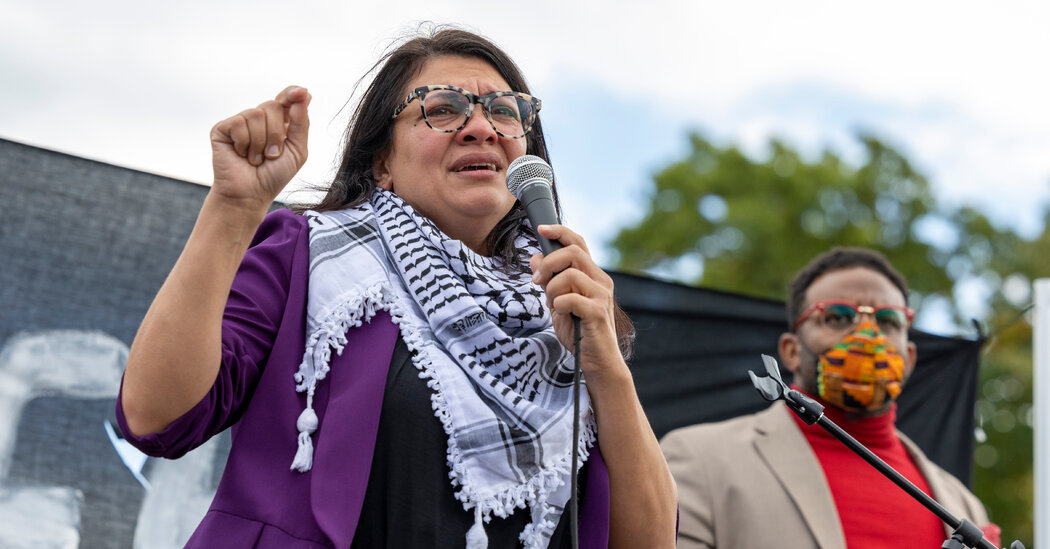Trump on Trial vs. Biden on the Trail: An Unusual 2024 Stretch Begins
American voters absorbed their first view of an extraordinary split-screen campaign this week, with President Biden sprinting across one of the country’s top battleground states and former President Donald J. Trump sitting — and appearing to snooze — in a New York courtroom.
Just as it has for years, the country’s political map has hardened into a battle across a handful of crucial swing states. Mr. Trump’s required appearance in a Lower Manhattan courtroom effectively leaves him little choice but to continue to be a weekend warrior in those states. Now, for much of the week, Mr. Biden has the electoral landscape largely to himself.
Mr. Biden campaigned across Pennsylvania, casting Mr. Trump as an out-of-touch plutocrat and collecting endorsements from the Kennedy family. In Scranton, the president’s childhood hometown, he jettisoned “Bidenomics” — the right’s derisive term for his economic policies that White House aides tried and largely failed to reclaim — in favor of arguing that voters faced a choice on the economy between “Scranton values or Mar-a-Lago values.”
Two days later, in Philadelphia, he connected the assassinations of President John F. Kennedy and Robert F. Kennedy to what he called Mr. Trump’s vision of “anger, hate, revenge and retribution” and embrace of political violence.
“Your family, the Kennedy family, has endured such violence,” Mr. Biden told several Kennedys as he accepted their support. “Denying Jan. 6 and whitewashing what happened is absolutely outrageous.”
The Pennsylvania trip was part of Mr. Biden’s shift into a more aggressive campaign stance against Mr. Trump. He has visited every battleground state since his State of the Union address in March, offering voters a retooled message that sharpens the contrast between the policies of the current president and his predecessor on a laundry list of issues, including abortion rights, democratic norms, tax policy and the economy.
The president’s attempt to transform the race into a binary choice between him and Mr. Trump — instead of a traditional re-election referendum on the incumbent — has been aided by the live play-by-play coverage of Mr. Trump’s courtroom appearances. So far, Mr. Biden and his team have been careful to say next to nothing about the trial or Mr. Trump’s other three criminal cases.
Yet the images require little narration. Campaigning across the country, Mr. Biden looks like a conventional presidential candidate. Sitting in a courtroom, Mr. Trump looks like a criminal defendant.
For months, Democratic strategists, candidates and officials privately worried that Mr. Biden’s campaign was falling short in what is widely expected to be a razor-thin contest, questioning the president’s energy levels, swing-state operations and message.
But the campaign’s new liveliness appears to be quelling some of that anxiety. Several Democrats praised the Biden team’s quick reaction last week, when it unleashed a multistate assault holding Mr. Trump responsible for an Arizona court ruling upholding a near-total 1864 abortion ban. Mr. Biden’s campaign has built a commanding financial advantage, leaving Mr. Trump scrambling to raise cash. And after facing criticism for slow hiring, the Biden operation now has 120 field offices and staff members positioned in every battleground.
Much of their effort in the past few weeks has been focused on ensuring that key parts of their coalition — Latino voters, Black voters and independents — understand the choice between Mr. Biden and Mr. Trump, with ads shown during nonpolitical TV shows, including “Abbott Elementary” and March Madness games.
David Axelrod, the architect of former President Barack Obama’s campaigns and one of the most vocal Democratic critics of Mr. Biden’s bid, complimented the campaign, saying the president was showing fresh “vitality and fight.”
“In this business, you’re either the stick or the piñata, and Biden has been more of a stick than a piñata over the last six weeks,” he said. “They are on their front feet and not their back feet, and that is the first requirement of winning.”
Campaign aides say that while they are monitoring Mr. Trump’s trial, they plan to keep their focus on the unemployment rate, inflation and other issues.
“We’re really focused on the American people and the kitchen-table issues that they’re talking about every single day,” said Quentin Fulks, Mr. Biden’s principal deputy campaign manager. “We don’t think that the American people are sitting around their kitchen table thinking about if Donald Trump is sleeping in court.”
It remains unclear how voters will respond to Mr. Trump’s legal peril and whether Mr. Biden can overcome negative views about his leadership. Recent polling by The New York Times and Siena College showed that Mr. Biden had nearly erased Mr. Trump’s early edge but also indicated that broad majorities of registered voters disapproved of the president’s handling of the economy, immigration, foreign conflicts and maintaining law and order.
On the trail, Mr. Biden has generally struck a more confident and forceful presence than the image of a doddering old man promoted by Mr. Trump, a continuation of the president’s confrontational State of the Union posture.
He showed particular emotion, and anger, when talking about comments Mr. Trump is said to have made about Americans killed in combat being “suckers” and “losers.” Mr. Biden has long believed that the 2015 death of his son Beau from brain cancer stemmed from his exposure to toxic burn pits while serving in Iraq.
“That man doesn’t deserve to have been the commander in chief for my son,” Mr. Biden said in Pittsburgh, choking up. (Mr. Trump denies having made those comments about U.S. soldiers.)
Supporters of Mr. Biden say they have seen a burst of energy from Mr. Biden as he campaigned across the country in recent weeks.
“You can just hear that he understands what’s at stake in this election,” said State Representative Malcolm Kenyatta, Democrat of Pennsylvania, who attended Mr. Biden’s speech in Philadelphia.
Still, Mr. Biden’s events remain tightly controlled, with many limited to invited guests, and the media often kept at a distance from unscripted interactions with voters. When Mr. Biden met with workers at a construction site in Pittsburgh — beneath a sign that said the project had been funded by Mr. Biden’s infrastructure bill — reporters were kept too far away to hear what the workers, who seemed to be expressing their gratitude, told the president.
He continues to be dogged by vocal protests of his support for Israel in the war in Gaza. All through the Pennsylvania trip, including during a visit to his childhood home in Scranton and overnight at his hotel, Mr. Biden was trailed by pro-Palestinian protesters, a reminder of the deep divisions in the Democratic Party over the war.
And his performance was not without some of Mr. Biden’s trademark embellishments. Twice on Tuesday, Mr. Biden implied that his uncle could have been eaten by cannibals after his plane was shot down over New Guinea during World War II. The U.S. government’s record of missing service members reported the plane was lost at sea in a crash and the bodies of the soldiers never recovered but made no mention of cannibalism.
At a carpenter’s union hall, Mr. Biden told a meandering anecdote about meeting his first wife, Neilia Hunter, on a college trip to the Bahamas and telling her that he planned to marry her on their first date. The story hinted at some clearly adult details.
“I swear to God, I hadn’t kissed her, we hadn’t done a single thing together,” Mr. Biden said to laughter, as he stood flanked by several children.
At times, the volume of his speaking voice fluctuated substantially, veering between booming and inaudible, and he made some verbal flubs and gaffes.
Those missteps attracted far less attention than Mr. Trump’s criminal case. Every aspect of the trial has been subject to intense media scrutiny, including details like whether Mr. Trump’s eyes remained open or closed as he listened to the proceedings.
In a statement attributed to an unnamed “spokesperson,” the Trump campaign denied that the former president was sleeping in court. But the incident underscored how little control Mr. Trump and his aides have over the optics of a campaign suddenly being fought from a courtroom. Most of Mr. Trump’s days are now subject to the rules of Justice Juan M. Merchan, the judge overseeing the case.
Mr. Trump’s advisers are trying to compensate for Mr. Trump’s restricted schedule with weekend rallies in swing states and weeknight campaign stops in New York City. But some have privately expressed concerns that the local events make the former president look smaller, as if he is campaigning for mayor or governor.
On Tuesday, Mr. Trump made a campaign stop at a bodega in Harlem, where he used a stabbing incident from 2022 to attack Democrats, including Manhattan’s district attorney, as too lax on crime. He suggested an upside of his trial was that it “makes me campaign locally, and that’s OK.”
Yet, rather than a well-lit platform in front of a packed crowd, Mr. Trump’s stage was a store that was essentially a narrow aisle and a sidewalk outside, though the patio of a neighboring restaurant was full of supporters who broke into chants of Mr. Trump’s name and “four more years.”
On Saturday, Mr. Trump will head to North Carolina for a rally at an airport hangar. Days later, he will return to the courtroom in Manhattan.
Maggie Haberman contributed reporting.


